Related Research Articles
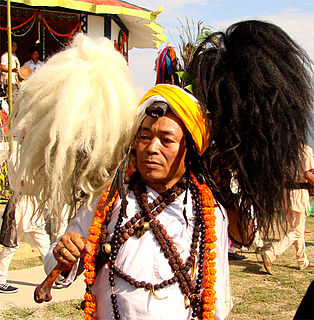
The Rai or Khambu are a Kirati ethnolinguistic group who mainly reside in the eastern parts of Nepal, the Indian states of Sikkim, West Bengal and in south western Bhutan.

The Limbu (exonym) or Yakthung (endonym) are Sino-Tibetan indigenous tribe of the Himalayan region of Eastern Nepal, Northern Sikkim, India and Western Bhutan.

Yakkha or Dewan is an indigenous ethnic group from the Indian subcontinent, mainly in modern-day Nepal and present-day India. It is one of the progenies of Nepal's prehistoric Kirat dynasty. The Yakkha people are subsistence farmers who inhabit the lower Arun valley in eastern Nepal. They number only a few thousand and their language is nearly extinct.

The Sunuwar or Koinch is an Kirati tribe of Nepal and some areas of India. They speak the Sunuwar language. According to the 2001 census of Nepal, 17% of the tribe follow the Kirant religion and adopt the Mundhum (Kiranti) culture.

Iman Xin Chemjong Limbu or Iman Singh Chemjong Limbu: was a Limbu historian, writer, linguist, lexicographer, folklorist and philosopher of Nepal. Although some say that his middle name Xin was spelled as Singh due to mainstream Nepalese or Indian influence, others say Singh is correct because in his book Kiratakalina Vijayapurako Sankshipta Itihasa, Chemjong writes his name in Nepali as Iman Singh Chemjong. Chemjong devoted his entire life to studying and documenting various facets of Kirat Limbu tradition and culture at a time when such activities were frowned upon and even punished by the Nepalese ruling elite as being subversive and "anti-national". Chemjong's research into, and publication of, a Kiranti history and culture challenged perceptions of the Nepalese official doctrine that showcased Nepal as a Hindu cultural monolith devoid of alternative narratives.
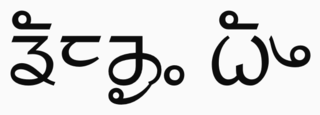
Limbu is a Sino-Tibetan language spoken by the Limbu people of Nepal and Northeastern India as well as expatriate communities in Bhutan. The Limbu refer to themselves as Yakthung and their language as Yakthungpan. Yakthungpan has four main dialects: Phedape, Chhathare, Tambarkhole and Panthare dialects.
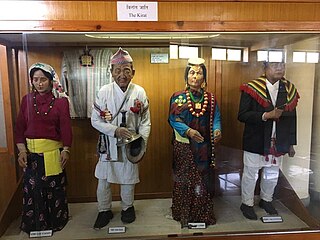
The Kirati people, also spelled as Kirant or Kiranti, are a Sino-Tibetan ethnic group. They are peoples of the Himalayas, mostly the Eastern Himalaya extending eastward from Nepal to North East India.

Budha Subba Temple (Manghim) or Budha Subba is a famous religious shrine of the eastern people of Nepal which is located at Bijayapur of Dharan, Nepal. The site is located on the top of the Seuti river bank, to small distance east of the Dantakali Temple. It is taken as an important place for religious people. Within the temple, two earthen piles have been raised which have the tradition of worshiping as the Budha Subba. The place has uniquely tip-less bamboo plants. The tips of these bamboos are believed to be broken by shots of slingshot used by Budha subba.Regarded by many as one of the, if not "The Most important cultural site of Eastern Nepal." The temple is crowded by people in Saturdays. Generally at Saturdays, sacrifices of rooster and pigs are made. The temple is systematically handled since 2015 BS.
The Limbu nation is made up of hundreds of clans. Each Limbu clans are classified under their Tribe or subnational entity or according to their place of origin. Almost all the Limbu clan names are unique, therefore it is not necessary to specify the Tribe or the place of origin every time the clan name is said.
About 104 million indigenous people in India are members of Scheduled Tribes, which accounts for 8.6 % of India's population. In the census of India from 1871 to 1941, tribals have been counted in different religions from other religions, 1871, 1881 (Aboriginal), 1891, 1901 (animist), 1911 (Animist), 1921 (Primitive), 1931, 1941 (tribes), However, in the 1951 census religion of tribals was not mentioned. In the 1961 census the religion of the tribals was mentioned as Saridharam, which is actually the religion of the Santal tribes of India. In 1971 also the religion of the Santal tribes was mentioned as Saridharam. In the 1981 census again no religion of any Indian tribe was mentioned. However again in the 1991 census the Santal religion Saridharam was mentioned as the religion of the Santal tribe. It should be mentioned that Saridharam is the recognised tribal religion of the Santal tribe of India and it comes under the purview of Special Marriage Act, 1954. The Santals and other Indian tribal communities are not Hindus, and do not belong to any Indo-Aryan religion like Hindu, Islam, Christianity, Buddhism, Sikh, Jainism and Persian. Many other Indian tribes adhere to their own traditional Indian tribal religions, often mistakenly syncretised with one or more of the Indo-Aryan religions like major religious traditions of Hinduism, Buddhism, Islam or Christianity and often under ongoing pressure of cultural assimilation.

Kirat Mundum, also known as Kirati MundumorKiratism, is the indigenous Indo religion of the Kirati ethnic groups of Nepal, Darjeeling and Sikkim, majorly practiced b /limbu Sunuwar,Yakkha, Thami, Jirel, Hayu and Surel peoples in the north-eastern Indo subcontinent. The practice is also known as Kirat Veda, Kirat-Ko Veda or Kirat Ko Ved. According to some scholars, such as Tom Woodhatch, it is shamanism, animistic religion or blend of shamanism, animism, and Shaivism. It is practiced by about 3.1% of the Nepali population. Its Limbu language slogan is,.
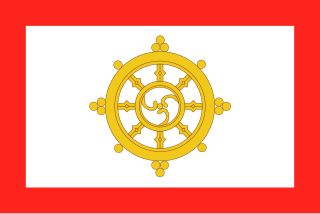
Sikkimese are people who inhabit the Indian state of Sikkim. The dominance ethnic diversity of Sikkim is represented by 'Lho-Mon-Tsong-Tsum' that identifies origin of three races since seventeenth century. The term 'Lho' refers to Bhutias (Lhopo) means south who migrated from Southern Tibet, the term 'Mon' refers to Lepchas (Rong) lived in lower Eastern Himalayas and the term 'Tsong' refers to Limbus, another tribe of Sikkim. Society in Sikkim is characterized by multiple ethnicity and possesses attributes of a plural society. The present population of Sikkim is composed of different races and ethnic groups, viz., the Lepchas, the Bhutias, the Nepalese and the Plainsmen, who came and settled in different phases of history. The Nepali community in Sikkim is inclusive of three sub-cultural ,sectors: the Kiratis, the Newaris and the Gorkhas.

Mundhum is the ancient religious scripture and folk literature of the Limbu. It is the ancient, indigenous religion of Nepal. Mundhum means "the power of great strength" in Limbu language. The Mundhum covers many aspects of the yakthung culture, customs and traditions that have been taken before Vedic civilisation in Indo subcontinent.
Chamling is one of the Kiranti languages spoken by the Chamling Rai(Malekungchha, Maidhung,kherasung,Rakhomi,Rodung, etc) of Nepal, India and Bhutan. Alternate renderings and names include Chamling, Chamlinge Rai and Rodong. It is closely related to the Bantawa and Puma languages of the Kiranti language family in eastern Nepal, and it belongs to the broader Sino-Tibetan language family. Chamling has SOV word order.

Sakela is one of the main festival of an ethnic group, indigenous native of Nepal, Sikkim and Darjeeling, Kalimpong Sakela is Celebrated twice a year and is distinguished by two names Ubhauli and Udhauli. Sakela Ubhauli is celebrated during Baisakh Purnima and Sakela Udhauli is celebrated during the full moon day in the month of Mangsir.
History of Limbuwan is characterized by the close interaction of Limbuwan with its neighbours independent and semi-independent rule characterized by autonomy for most of its time.
Te-ongsi Sirijunga Xin Thebe Limbu was an 18th-century Limbu scholar, educator, historian, linguist, leader, and philosopher of Limbuwan and Sikkim. He was formally known as Sirichongba and even more popularly known as "Sirijunga."
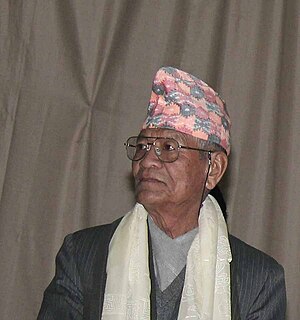
Til Bikram Nembang Limbu, popularly known as Bairagi Kainla or Bairagi Kaila ; is a senior litterateur of Nepal. He has served as Chancellor of the Nepal Academy from 2066 BS to 2070 BS. Part of his significant literary struggle was the Tesro Aayam movement. During the early 1960s, he with Ishwor Ballav and Indra Bahadur Rai searched unexplored realms of Nepali literature. They added a new dimension – the third dimension – to Nepalese literature.
Mahaguru Phalgunanda also known as "Mahaguru Phalgunanda" or Phalgunanda Lingden (1885–1949) was a leader of Kirat religion in Nepal Kirat people of Nepal.

Kirat Region is an area of the Himalaya of ethnic Kirati people of Nepal in the eastern region.
References
- ↑ "History of the Kirat People" (PDF). Limbulibrary.com.np. Retrieved 2013-09-01.
- ↑ Subba, J. R. (2009). Mythology of the People of Sikkim - J. R. Subba - Google Books. ISBN 9788121210232 . Retrieved 2013-09-01.
